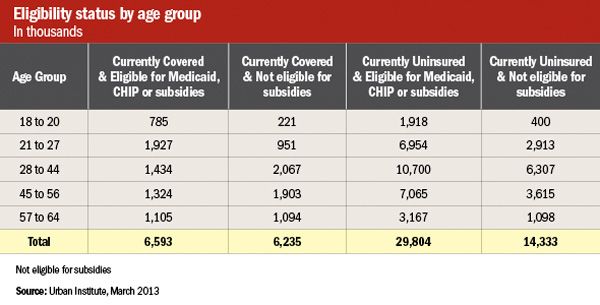Rate shock now less shocking
The 21 to 27 age group will see net costs increase $470, and that's the worst of it
Subsidies and access to employer-sponsored insurance and Medicaid will help shield the population that is expected to experience “rate shock” when the mandatory 3-to-1 age rating bands go into effect, according to analysis by the Urban Institute. Current age rating ratios can typically be 5-to-1 or greater.
Using a simulation model, the organization was able to illustrate modest impact on out-of-pocket outlays for younger nongroup purchasers once subsidies and other protections were figured in. The study notes that many enrollees in the health exchanges will be eligible for subsidies.
For example, 92% of those age 21 to 27 will have incomes below 300% of federal poverty level. Among those in this age group with current nongroup coverage, 67% would be eligible for Medicaid, CHIP or subsidies.
However, this age group is the most likely to see higher net costs under the 3-to-1 age rating bands. Net costs encompassing premiums, plus out-of-pocket, less subsidies, could increase from $5,350 in the 5-to-1 ratio to $5,820 in the 3-to-1 situation-a difference of an additional $470. Other age groups see less of a difference.

Extending the Capabilities of the EHR Through Automation
August 2nd 2023Welcome back to another episode of "Tuning In to the C-Suite," where Briana Contreras, an editor of Managed Healthcare Executive, had the pleasure of chatting with Cindy Gaines, chief clinical transformation officer at Lumeon.
Listen